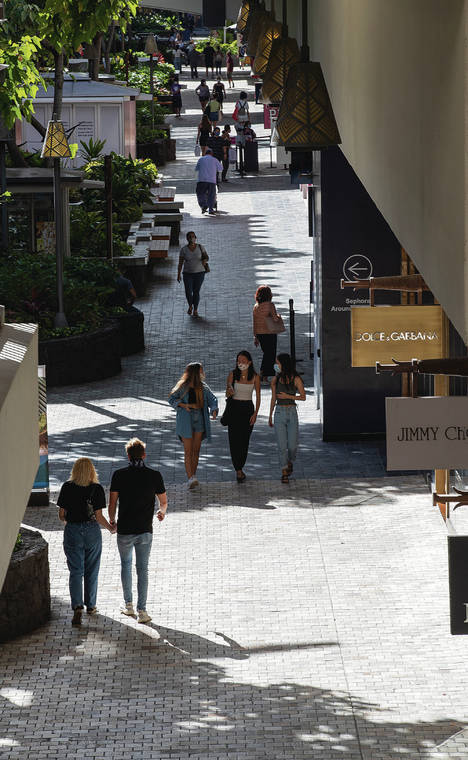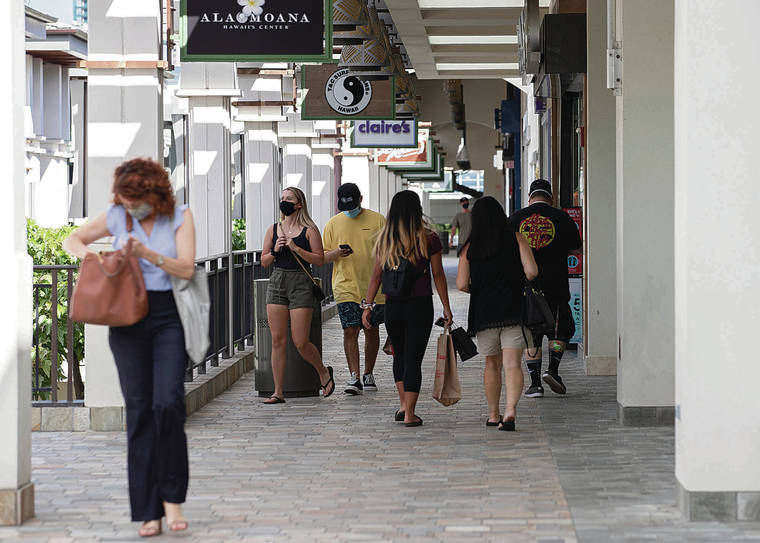Gov. David Ige and Mayor Kirk Caldwell use another targeted approach to combat COVID-19 surge on Oahu


CINDY ELLEN RUSSELL / CRUSSELL@STARADVERTISER.COM
Mayor Kirk Caldwell’s new emergency order includes the requirement of face coverings in malls, whether the mall is enclosed or not.

CINDY ELLEN RUSSELL / CRUSSELL@STARADVERTISER.COM
Mayor Kirk Caldwell has called another emergency order due to the triple-digit COVID-19 cases Hawaii has been having recently. The mandate begins at midnight today. At left, patrons don the now required face coverings Tuesday at Ala Moana Center.



With surging cases of COVID-19 and growing calls for more restrictions, many were anticipating that Gov. David Ige and Honolulu Mayor Kirk Caldwell would reimpose a stay-at-home lockdown for Oahu.
Instead, they used what they called a more targeted approach Tuesday in prohibiting Oahu residents from gathering in groups of more than five.
“We’ve been struggling over the past four or five days on whether we use a scalpel or a hammer to attack the spiking of COVID-19 on the island of Oahu. But we’ve chosen the scalpel for now,” Caldwell said at a virtual news conference.
Ige, meanwhile, announced the delay of the state’s planned pre-travel COVID-19 testing program for at least a month, or until pandemic conditions are safe enough to allow trans- Pacific travel.
For at least a week Ige had been saying he was seriously looking at pushing back the much-anticipated program viewed as the beginning of the relaunch for Hawaii’s beleaguered tourism industry.
Ige explained that Hawaii has seen nearly 3,000 cases since Aug. 1, a total that exceeded the number of cases here from March to July.
Don't miss out on what's happening!
Stay in touch with breaking news, as it happens, conveniently in your email inbox. It's FREE!
Caldwell said that under his new “Act Now Honolulu — No Social Gatherings” emergency order there should be no social gatherings indoors or outdoors for 28 days starting today at midnight.
“By that we mean no parties larger than five coming together, whether it be in a private or public setting, within your home, inviting neighbors over. No social gatherings. Be careful,” he said.
More restrictions include:
>> Face coverings required in malls, whether the mall is enclosed or not.
>> For in-person spiritual services, face coverings are mandated at all times with no singing or wind instruments allowed.
>> Restaurants are limited to seating groups no larger than five people, down from 10.
>> All social gatherings at business offices are prohibited, with all common eating areas closed.
“We’re asking that businesses around this island to reduce the number of employees at offices on a daily basis by either encouraging telecommuting, working from home or staggered work schedules, so there is not as many people in one place at one time,” he said.
In addition, Caldwell said outdoor attractions, recreational commercial boating activities and water parks can remain open but with groups of no more than five.
Beaches, parks, hiking trails and bars remain closed, he added.
“What is open with these limits? Restaurants, retail, spiritual services, offices, fitness centers, personal services, child care, education, health care, auto dealerships and real estate,” he said.
Ige already had delayed by a month the proposed program to allow passengers with approved negative COVID-19 tests taken within 72 hours of their trip to Hawaii to bypass the state’s mandatory 14-day self- quarantine for out-of-state passengers.
Now, the program, Ige said, will not start until Oct. 1 at the earliest.
“We will continue to monitor the conditions here in Hawaii as well as key markets on the mainland to determine the appropriate start date for the pre-travel testing program,” he said.
Ige added that an announcement on the new start date will provide plenty of notice to the hospitality industry so that it has enough time to add staffing.
The 14-day neighbor island quarantine program remains in effect, he said.
Keith Vieira, a former hotel executive and now hospitality industry consultant, said he was disappointed by the governor’s announcement. The industry is suffering, he said, and repeat customers who had rebooked their vacations for a later date are now giving up and going elsewhere.
“They should pick a date and live with it,” Vieira said. “With the recent spike, I don’t think there’s a direct correlation to visitors.”
On Tuesday, Hawaii health officials reported 134 new coronavirus cases, raising the statewide total since the start of the pandemic to 5,349. The new cases included 124 on Oahu, seven in Maui County, and three on Hawaii island.
Officials also announced another death from COVID- 19, an Oahu man between the age of 40 and 59 years old with underlying health conditions. The statewide death toll is now 41.
Officials counted 1,914 new tests in Tuesday’s tally, with the 134 positive cases representing about 7% of the total tested. For the past week, Hawaii’s positivity rate was 7.8%, which is higher than the 5% the World Health Organization recommends to governments before reopening.
In another related development, 34 additional Oahu Community Correctional Center inmates and four staff tested positive in the state’s largest virus cluster, which has now reached 215 cases. All remaining inmates are expected to be tested in the coming days.
With the second lowest daily case count since Aug. 2, state Health Director Bruce Anderson sounded an optimistic tone Tuesday, saying the number of cases had leveled off statewide and hospital bed usage was lower than projected.
“I’m told that we are not at a crisis level at this point,” he said. “Hopefully, we’ve turned a corner here, and we’re going to start seeing a lower number of people going to the hospital and certainly fewer people dying from the disease.”
Even with the surge in cases, Hawaii leads the country in the fewest deaths per capita.
Anderson said the U.S. Department of Health and Human Services informed the state that it will be receiving extra support because of the recent virus surge.
That means Hawaii will be at a higher priority for getting laboratory supplies, reagents and other chemicals that will help testing occur at faster rates.
“Along with the supplies, we hope to get additional federal support to help us in managing the situation here,” he said.
Anderson, who took some time off last week, told reporters that the short vacation allowed him to rest and rejuvenate.
“I appreciate the governor granting me that brief time to rest, since we have all been at this nonstop since the pandemic began,” he said. “Let me reassure you that I am at work, directing the Department of Health’s response and (state Epidemiologist) Dr. Sarah Park is at work continuing to guide our disease outbreak control measures. We all need a break periodically to keep working at our optimum level and to be effective.”




